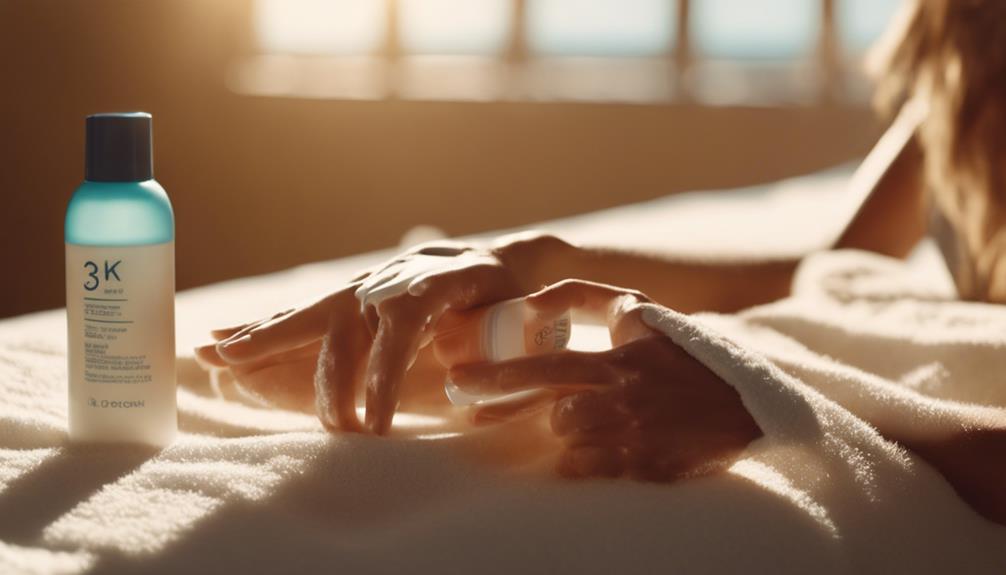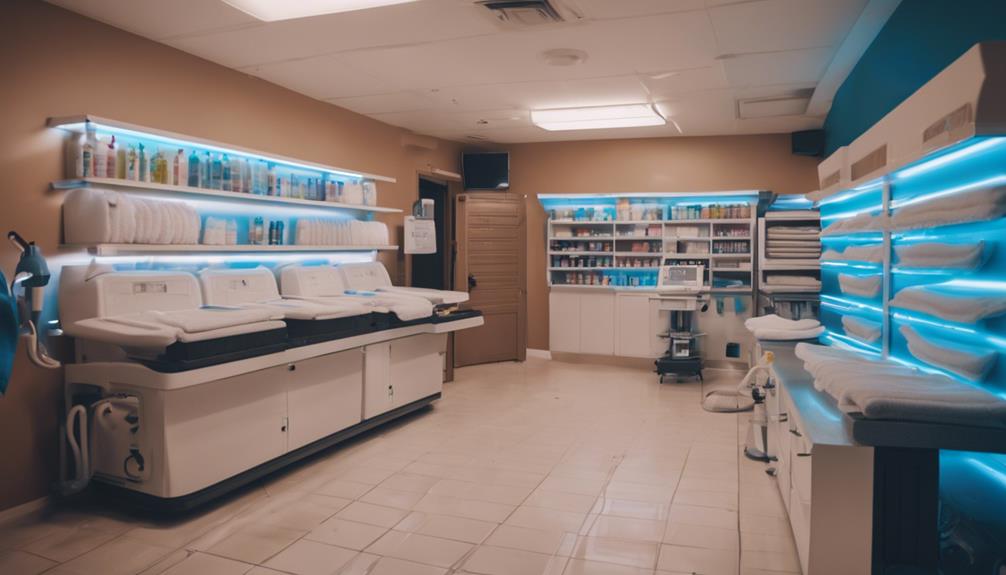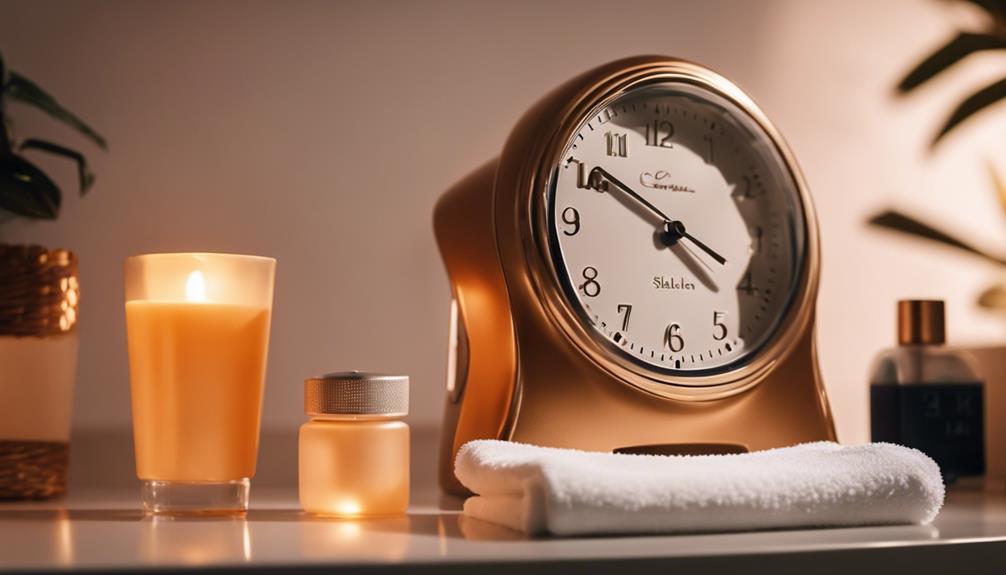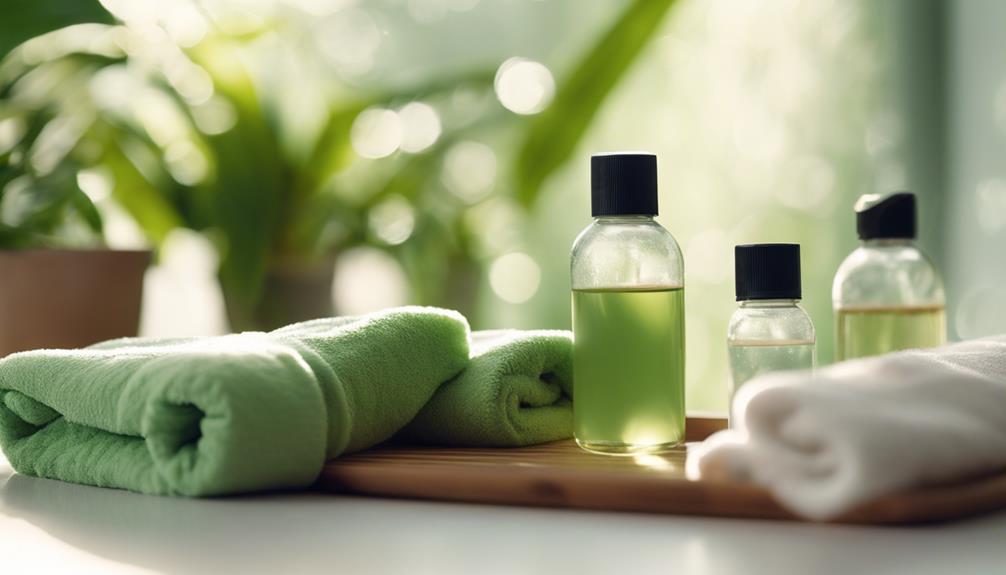To guarantee safe tanning bed use, consider your skin type and follow a few key tips. Start with short sessions and gradually increase the duration, using a timer to avoid overexposure. Always wear UV-blocking goggles to protect your eyes and use SPF lip balm to prevent lip dryness. Apply bronzer evenly for the best results, and remember to moisturize before and after your tanning sessions to enhance your tan and keep your skin healthy. Finish with tan-extender lotions for lasting results. There's plenty more you can learn to perfect your tanning routine effectively.
Key Takeaways
- Identify your skin type and adjust tanning bed sessions accordingly to minimize UV risks and optimize results.
- Always wear UV-blocking goggles to protect your eyes from harmful tanning bed rays.
- Use a timer to monitor session duration and prevent overexposure to UV light.
- Apply a moisturizer or tan-extender lotion immediately after tanning to lock in moisture and prolong your tan.
Understanding Skin Types
Understanding your skin type is crucial for safe tanning, as it helps you determine the right approach to minimize the risk of burns and damage.
If you have fair skin, tread carefully; you're more prone to UV-related issues and should start with short sessions. For pale and light brown skin types, gradual exposure is key to achieving a beautiful tan.
Remember, olive or bronze skin isn't immune to UV damage either, so protective measures are still important.
Before tanning, exfoliate your skin 24 hours in advance for even results, and moisturize regularly to keep your skin hydrated.
Avoid lotions with oils or fragrances before tanning, and always perform a patch test with new products to prevent any adverse reactions.
Optimizing Tanning Bed Sessions
Knowing your skin type helps you tailor your tanning bed sessions for ideal results while minimizing the risk of damage.
Start with shorter sessions, gradually increasing the time as your skin adjusts. Use a timer to avoid overexposure and keep a close eye on how your skin reacts.
Limit your sessions to recommended durations, following the manufacturer's guidelines closely. Maintain skin hydration before and after tanning to support recovery and enhance your tan.
Opt for quality tanning products designed for indoor use, as they can boost results while protecting your skin.
Essential Protective Gear

Protective gear is essential for ensuring your safety and comfort during tanning bed sessions.
Start with UV-blocking goggles that fit snugly, safeguarding your eyes from harmful rays. Don't forget a lip balm with SPF to prevent dryness and cracking.
To shield sensitive areas, wear comfortable swimwear or cover-ups that allow for even tanning while protecting your skin. Consider using a face cover specifically designed for tanning beds to block UV exposure effectively.
Finally, applying tan-extender lotions post-session helps lock in moisture and prolong your tan.
Choosing the Right Bronzer
Selecting the right bronzer can greatly enhance your tanning results while ensuring an even and natural-looking glow. Look for bronzers that complement your skin tone to avoid any unwanted streaking.
Moisturizing bronzers are ideal, as they keep your skin supple during the tanning process. Indoor tanning bronzers specifically designed for use with tanning beds help minimize UV exposure risks, so opt for those whenever possible.
Additionally, consider products infused with antioxidants and vitamins for added nourishment. Always check the ingredient list for any potential irritants, especially if you have sensitive skin.
Proper Application Techniques

To achieve an even and natural-looking tan, you should apply bronzer evenly across your skin, ensuring you cover all areas without leaving gaps or streaks. Start by using a small amount of bronzer and gradually increase as needed. Use your hands or a tanning mitt for smooth application. Always blend in circular motions for a seamless finish.
| Step | Tips |
|---|---|
| 1. Preparation | Exfoliate and moisturize skin before applying bronzer. |
| 2. Application | Use a tanning mitt for even coverage. |
| 3. Even Coverage | Work in small sections to avoid missed spots. |
| 4. Blend | Blend bronzer in circular motions for a natural look. |
| 5. Evaluate | Check for streaks and touch up if necessary. |
Post-Tanning Skin Care
Post-tanning skin care is essential for maintaining your glow and ensuring your skin remains healthy and hydrated. After your tanning session, follow these crucial steps to care for your skin:
- Apply tan-extender lotions immediately to lock in moisture and prolong your tan.
- Use a high-SPF lip balm to protect your lips from drying out or cracking.
Remember to monitor your skin for any unusual changes, and consult a dermatologist if you notice anything concerning.
Taking these steps not only enhances your tan but also keeps your skin looking vibrant and feeling soft.
Prioritize post-tanning care to enjoy your beautiful results longer!
Maintaining Tanning Equipment

Maintaining your tanning equipment is essential for guaranteeing ideal performance and hygiene during each use.
Start by cleaning the tanning bed before and after each session. Use disinfectant wipes or sprays specifically designed for tanning beds to eliminate bacteria and germs.
Regularly inspect the bulbs to verify they're functioning properly; replace them as needed to maintain peak tanning results. It's also important to check the bed's reflectors for dust and dirt buildup, which can diminish effectiveness.
Additionally, confirm that the bed's settings are correctly calibrated for your skin type and desired tan.
Frequently Asked Questions
How Often Can I Use a Tanning Bed Safely?
You can safely use a tanning bed about two to three times a week, allowing your skin time to recover. Monitor your skin's response and adjust frequency as needed to avoid damage or burns.
What Should I Do if I Get Burned?
Imagine your skin's like a delicate canvas. If you've gotten burned, cool it with aloe, hydrate, and avoid further tanning. Your skin needs time to heal; listen to it, just like an artist respects their masterpiece.
Can I Tan if I Have Skin Conditions?
If you have skin conditions, it's best to consult a dermatologist before tanning. They'll help you understand risks and suggest safe alternatives, ensuring your skin stays healthy while you achieve your desired tan.
Are There Age Restrictions for Tanning Bed Use?
Imagine a golden sun, but age can cast shadows over tanning bed use. Many places restrict it under 18, recognizing youthful skin's vulnerability. Always check local regulations and prioritize skin safety over the allure of a bronze glow.
Can I Use Tanning Beds While Pregnant?
You shouldn't use tanning beds while pregnant. The increased body temperature and UV exposure can pose risks to your developing baby. It's best to consult your healthcare provider for safe alternatives to achieve a tan.
Conclusion
In your quest for that perfect tan, think of your skin as a delicate canvas.
Just as an artist carefully selects colors and techniques, you need to optimize your tanning bed sessions and protect your skin with the right gear and products.
By following these essential tips, you can achieve a beautiful glow while keeping your skin healthy and vibrant.
Embrace the process, and remember, a safe tanning journey leads to a masterpiece you can proudly show off!









